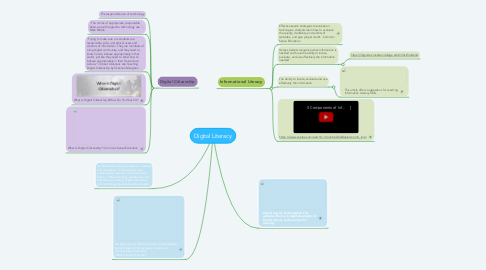Digital Literacy
by Heather Hitchen


1. Digital Citizenship
1.1. The responsible use of technology
1.2. "The norms of appropriate, responsible beha-vior with regard to technology use." - Mike Ribble
1.3. "Trying to make sure our students are responsible, safe, and ethical users and creators of information. They are members of a big digital community, and they need to know how to behave appropriately in that world, just like they need to know how to behave appropriately in their face-to-face culture." -School Librarians Are Teaching Digital Citizenship by Shannon Maughan
1.4. What Is Digital Citizenship & How Do You Teach It?
1.5. What Is Digital Citizenship? | Common Sense Education
2. the ability to use information and communication technologies to find, evaluate, create and communicate information. -What Is Digital Literacy?
3. Six Standards for Digital Literacy: creativity and innovation, communication and collaboration, research and Information fluency, crtitical thinking, problem solving and decision making, digital citizenship, and technology operations and concepts.
4. Informational Literacy
4.1. Effective search strategies to evaluation techniques, students learn how to evaluate the quality, credibility, and validity of websites, and give proper credit. -Common Sense Education
4.2. Helps students recognize when information is needed and have the ability to locate, evaluate, and use effectively the information needed
4.2.1. https://libguides.madisoncollege.edu/InfoLitStudents
4.3. The ability to locate, evaluate and use effectively the information
4.3.1. This article offers suggestions for teaching Information Literacy Skills
